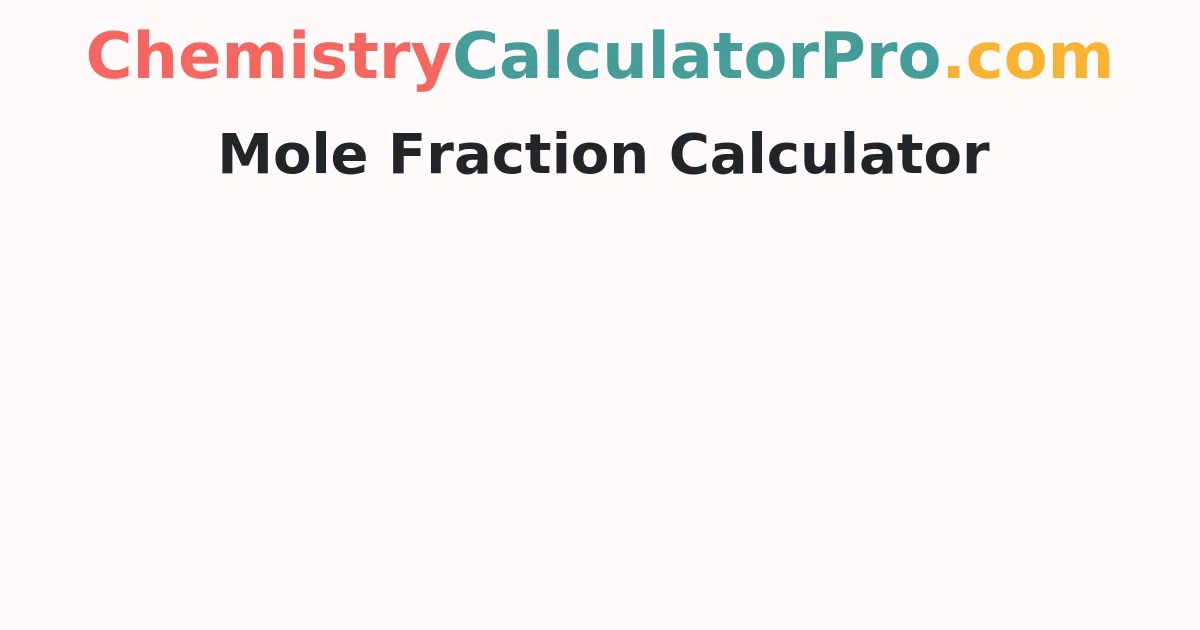Mole Fraction Calculator
The mole fraction calculator is a computer tool that allows you to calculate the mole fraction. The mole ratios calculator saves the user a lot of time that would otherwise be spent manually calculating mole fractions.
Mole - Definition
The mass of any compound, measured in grammes, that equals the masses of the component elements measured in atomic mass units is defined as a mole.
Mole Fraction - Definition
A mole fraction is a concentration measure used to describe the amount of an active compound in chemistry. Divide the number of moles of one component of a solutions by the overall number of moles of all components of a solutions to get the mole fraction. This should be emphasized that the mole fractions of all the constituents in the solution should add up to one.
Mole Fraction Formula
A mole fraction is a measurement of a chemical solution's concentration. It is computed by dividing the number of moles of one solution component by the total number of moles of all solution components. The mole fraction of all elements in a solution must always add up to one.
Mole Fraction = (Moles of the Solute) / (Moles of the Solute + Moles of the Liquid) = (Moles of the Solute) / (Moles of the Solvent)
What Is a Mole Fraction Calculator and How Do I Use It?
The following steps will explain you on how to use the mole fraction calculator. They are as under
- In the appropriate input fields, enter the moles of solute, solvent, and x for the unknown.
- To receive the result, click the "Calculate x" button.
- Enter the input mass of the substance.
- Finally, in the output field, the mole fraction of the chemical component will be presented.
Mole Fraction Examples
Example 1: If a water molecule contains 1.33 moles of hydrogen and 0.6 atoms of oxygen, find the molar fraction of each reactant (hydrogen and oxygen)?
Solution:
1.33mol divided by 1.93mol=0.68
0.6mol divided by 1.93mol=0.31
In a water molecule, the molar percentage of hydrogen is 0.68, and the molar fraction of oxygen is 0.31. (The total number of moles of the reactants is 1.93: 1.33mol + 0.6mol = 1.93mol.)
Example 2: Calculate the mole fraction of CH3OH and H2O in a solution made by combining 5.5 g of alcohol with 40 g of water. H2O has a molar mass of 18 while CH3OH has a molar mass of 32.
Solution:
CH3OH Moles = 5.5 / 32 = 0.17 mole
H2O Moles = 40 / 18 = 2.2 moles
As a result, based on the equation CH3OH Mole Fraction = 0.17 / (2.2 + 0.17)
CH3OH Mole Fraction = 0.073
FAQ’s on Mole Fraction Calculator
1. In a combination containing 50.0 weight urea in cinnamic acid, what is the mole fraction of cinnamic acid?
This equates to 50.0 g urea and 50.0 g cinnamic acid. The number of moles present can then be calculated by dividing each by its molecular weight. We have 1.22 moles total, with 0.833 moles urea and 0.388 moles cinnamic acid. Cinnamic acid's mole fraction is 0.318.
2. How do you calculate hexane's mole fraction?
Hexane has a mole fraction of 0.116 / (0.116 + 0.109 + 0.119) = 0.337, whereas toluene and cyclohexane have mole fractions of 0.317 and 0.346, respectively.
Moles = mass of the substance in grams/molecular weight.
3. What is the formula for calculating molar concentration?
We will compute the molar concentration by dividing the moles by the number of litres of water utilised in the solution.
4. Is the use of hexane and pentane the best option?
At 25° C, pentane and hexane have vapour pressures of 511 torr and 150 torr, respectively.
5. How can you figure out what the final pressure is?
Make a calculation for the final pressure. p1 x V1 = p2 x V2 When you rearrange the numbers, you get p2 = (p1 x V1) / V2.
